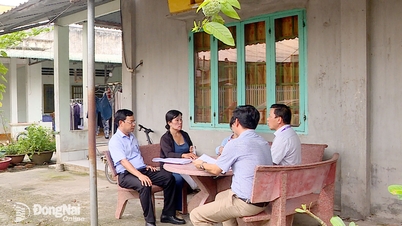In 2023, the average number of children a Vietnamese woman will have will be 1.96, the lowest in 63 years and is forecast to "continue to decline in the coming years".
At the ceremony held on the occasion of World Population Day on July 11, the leader of the Ministry of Health said that the birth rate in our country still has significant differences between regions and subjects; the birth rate trend is low; the rate of increase in the sex ratio at birth is still high compared to the natural balance. Along with that, Vietnam has not yet had a synchronous solution to adapt to population aging while population aging is an inevitable trend of countries. This poses great challenges, which need to be assessed and changed in policy approaches to the issue, because population is the story of the country's future. The series of articles "Population challenges in Vietnam" will provide some data, current status and trend assessment of the population situation in our country.
The trend of not wanting or having very few children has appeared.
According to the Ministry of Health , one of the biggest challenges facing some countries is the rapid aging of the population and the sharp decline in birth rates. The birth rate of Asian women is among the lowest in the world. The reason why young people in many Asian countries have few children, or even no children, is because they have difficulty having enough money to raise a child. Although her eldest daughter is 8 years old, Ms. Quynh (32 years old, HCMC) still has no intention of having a second child despite being urged many times by her family. The situation of renting a house and having an unstable income for nearly a decade has haunted her, and she does not dare to have another child because of the worry of "not being able to take care of her children properly". According to the latest data from the HCMC Department of Population, the average number of children of a woman of childbearing age like Ms. Quynh in the most dynamic city in the country is 1.32, while last year it was 1.42. For nearly 20 years, the birth rate in Ho Chi Minh City has fluctuated at 1.24-1.7, much lower than the replacement rate (2-2.1 children). In fact, one of the reasons for the low birth rate here is that before deciding to get pregnant, many women wonder and worry about whether they have enough money to give birth and raise a child? Who will take care of the children after giving birth so that the mother can go to work?... On a national level, Vietnam has achieved and maintained the replacement fertility rate for the past 15 years (since 2006, Vietnam officially reached the replacement fertility rate (2.09 children). In 2023, for the first time, Vietnam witnessed the lowest total fertility rate since the implementation of the population program (in 1960). The fertility rate has decreased sharply, currently below 2 children. According to the General Statistics Office, the average population in 2023 of our country is estimated to reach 100.3 million people, an increase of nearly 835,000 people, equivalent to an increase of 0.84% compared to 2022. In the 10 years 2013-2023, on average, Vietnam's population increased by about 1 million people per year. This shows that Vietnam's fertility rate has decreased significantly, notably, the Ministry of Health predicts that the fertility rate will continue to decrease in the coming years.Proposal to remove the regulation that couples can only "have one or two children"
The 2008 Population Ordinance amends Article 10 of the 2003 Population Ordinance, which stipulates that each couple and individual can "decide the time and spacing of children" and "give birth to one or two children, except in special cases prescribed by the Government ." Based on this provision, the Government stipulates seven cases that do not violate the regulation of giving birth to one or two children. However, the Ministry of Health said that this provision of the Population Ordinance is no longer consistent with the 2013 Constitution. The Population Bill drafted by the Ministry of Health will not stipulate the number of children for each couple but will give the right to decide and the obligation to each individual and couple. This is considered a fundamental change in the Population Bill compared to the Population Ordinance. Accordingly, couples and individuals have the right to decide voluntarily, equally and responsibly on having children, the time of giving birth, the number of children and the interval between births in accordance with the age, health status, conditions of study, work, work, income and child-rearing of the couple and individual. At the same time, couples and individuals have the obligation to ensure the responsibility of caring for, raising and educating their children well. The drafting agency said that giving individuals and couples the right to decide the number of children will avoid the situation of the birth rate falling too low, causing population aging, negatively affecting economic and social development, ensuring national defense and security. At the same time, it will overcome the situation of people with conditions to raise children having few children, while people with less conditions to raise children having many children, significantly affecting population quality. "Not regulating the number of children will be consistent with Vietnam's political commitments at multilateral forums and will have a positive impact on international public opinion," the Ministry of Health's report stated. In particular, the state needs to ensure the budget to support and encourage material and spiritual benefits for people implementing the policy. Provinces and cities must have policies to encourage and support material and spiritual benefits for couples to maintain the replacement fertility rate in the area, in accordance with economic and social development conditions. In the report assessing the impact of the Population Bill, the Ministry of Health cited a series of lessons on policies related to fertility in a number of Asian countries. Japan, a country with a very low birth rate, is implementing unprecedented measures to change the trend of population decline. Japan has established a child and family agency. The country's authorities have pledged to double child benefits. This is Japan's effort to reduce the burden on households when giving birth and caring for young children. In China, for the first time in more than 60 years, the country of more than 1.4 billion people witnessed a population decline in 2022. In this country, the birth control policy was changed in 2016, according to which each couple is allowed to have 2 children. In August 2021, China amended the Population Law, according to which couples are allowed to have 3 children. However, the Chinese government is also calling on party members to have three children as an example to contribute to population growth. Singapore's fertility rate began to decline in the early 1960s, reaching below replacement level in 1975, then falling further to very low levels in the early 2000s and has remained very low ever since. As of 2011, Singapore's total fertility rate was just 1.2 children per woman, far below the level needed to maintain population size and keep the age structure balanced.


![[Photo] Enjoy the Liuyang Fireworks Festival in Hunan, China](https://vphoto.vietnam.vn/thumb/1200x675/vietnam/resource/IMAGE/2025/10/26/1761463428882_ndo_br_02-1-my-1-jpg.webp)

![[Photo] Nhan Dan Newspaper displays and solicits comments on the Draft Documents of the 14th National Party Congress](https://vphoto.vietnam.vn/thumb/1200x675/vietnam/resource/IMAGE/2025/10/26/1761470328996_ndo_br_bao-long-171-8916-jpg.webp)
![[Photo] General Secretary To Lam received the delegation attending the international conference on Vietnam studies](https://vphoto.vietnam.vn/thumb/1200x675/vietnam/resource/IMAGE/2025/10/26/1761456527874_a1-bnd-5260-7947-jpg.webp)
































![[Photo] Prime Minister Pham Minh Chinh attends the opening of the 47th ASEAN Summit](https://vphoto.vietnam.vn/thumb/1200x675/vietnam/resource/IMAGE/2025/10/26/1761452925332_c2a-jpg.webp)










































































Comment (0)